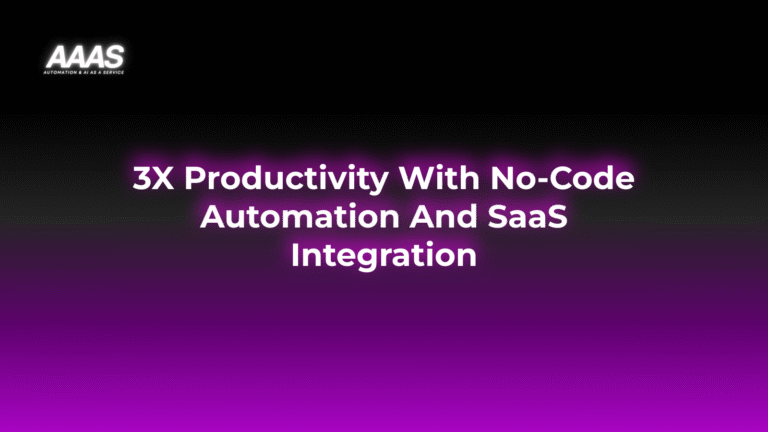The Market Problem: Productivity Gaps in SaaS Workflows
With organizations adopting dozens of SaaS applications—CRM, project management, email marketing, HR, support—the risk of siloed data, manual entry, duplicate tasks, and missed deadlines is enormous. According to Harvard Business Review, employees switch between tools over 1,200 times a day, wasting around 32 work days per year.

- Manual processes slow down innovation
- Rekeying errors cost revenue
- Lack of integration hinders agility
These productivity gaps hurt business outcomes, increase costs, and erode ROI.
Solution & Benefits: No-Code Automation and SaaS Integration

What is No-Code Automation?
No-code automation enables anyone—even non-developers—to connect SaaS tools, automate workflows, and orchestrate data without writing a single line of code. By using visual interfaces and drag-and-drop logic, businesses can:
- Automate repetitive tasks across CRM, marketing, support, and more
- Synchronize data in real-time between platforms
- Streamline approval processes and reduce human bottlenecks
SaaS Integration for Productivity
Connecting core SaaS apps (e.g., Slack, Salesforce, Mailchimp, Asana) ensures seamless data flow and removes friction, allowing users to focus on value-added tasks.
Key Benefits
- Productivity: Recover hours per week previously lost to manual work
- Efficiency: Reduce errors and repetitive tasks
- ROI: Lower operational costs and accelerate time-to-value
- Scalability: Build automations that grow with your business
Real Use Cases
Marketing
- Automate lead capture from web forms to CRM and email nurtures
- Trigger personalized follow-ups post-event without manual lists
Sales
- Auto-create opportunities in CRM from inbound emails
- Send contract documents for e-signature based on deal stage
HR & Recruitment
- Onboard employees by syncing HR platforms, calendars, and documentation
Support
- Escalate high-priority tickets to Slack channels instantly
- Sync customer feedback between survey tools and helpdesks
For more examples, see No-Code Automation Use Cases.
Technical Details: How No-Code Automation Works
- Connectors & APIs: Pre-built integrations for popular SaaS apps
- Triggers: Event-based actions (e.g., form submission, new contact)
- Actions: Automated responses (e.g., update record, send message)
- Conditional Logic: IF/THEN paths to customize workflows
- Security: OAuth, encrypted tokens, audit logs for compliance

Most platforms offer templates for common processes and allow custom logic via visual editors.
Comparison with Alternatives
| Feature | No-Code Automation | Traditional Development | Manual Processes |
|---|---|---|---|
| Implementation Time | Minutes to Hours | Weeks to Months | Immediate, but slow tasks |
| Required Skills | Any user | Developers/IT | Any user |
| Scalability | High | High | Low |
| Cost | Low-Medium | High | Hidden, long-term |
| Flexibility | Medium-High | High | Low |
| Error Rate | Low | Low | High |
Pricing Table of Leading Tools
| Tool | Starting Price/Month | Main Features | Free Tier? |
|---|---|---|---|
| Zapier | $19.99 | Multi-step workflows, 5,000+ app integrations | Yes |
| Make (Integromat) | $9.00 | Advanced scenarios, data processing | Yes |
| Workato | $249 | Enterprise-grade, AI automation | No |
| Tray.io | $695 | High-scale, API integration | No |
ROI-Focused Practical Examples
- Case 1: Lead Management Automation
A professional services agency automated lead qualification using Zapier, saving 15 hours/month by connecting web forms to CRM and email. Annual savings: $6,400 in labor costs.
- Case 2: E-commerce Fulfillment Sync
An e-commerce company integrated Shopify, ShipStation, and Xero using Make. Order errors dropped by 95%, reclaiming an estimated $10,000 annually in prevented returns and manual corrections.
- Case 3: HR Onboarding
A growing tech startup reduced IT support time by 50% during onboarding by integrating BambooHR, Slack, and GSuite. ROI realized within one month.
How to Set Up No-Code Automation
- Identify Pain Points: List repetitive manual tasks across teams.
- Choose a No-Code Platform: E.g., Zapier, Make, Workato, Tray.io.
- Connect SaaS Tools: Authorize connections using OAuth or secure API keys.
- Build and Test Workflows: Use visual editors to map triggers and actions.
- Monitor and Optimize: Set up alerts, error handling, and analytics.
For setup guides, see No-Code Automation Setup Steps.
Pros and Cons
| Pros | Cons |
|---|---|
|
|
Expert Tips for Maximum Efficiency
- Start small—automate a single process before scaling organization-wide
- Document all automations for handover and troubleshooting
- Review automation logs monthly for errors and improvements
- Combine no-code tools with low-code features if advanced customization is needed
- Regularly update authorizations to ensure secure integrations
FAQ
- Is no-code automation secure?
- Yes. Leading providers use encrypted connections, OAuth authentication, and offer audit trails. Select tools with strong compliance certifications (e.g., SOC2, GDPR).
- How many SaaS tools can I integrate?
- Popular platforms like Zapier and Make offer thousands of integrations; check exact app compatibility before purchase.
- What happens if a connected app changes its API?
- Good workflow tools alert users to integration errors and may offer migration tools for API changes.
- Can I build complex workflows?
- Yes, via multi-step automations, conditional branching, and built-in logic features.
- How quickly can automation deliver ROI?
- Many users see immediate ROI within weeks through reclaimed staff time and reduction in process errors.
References & Citations
- Harvard Business Review, Productivity Study
- Zapier: The No-Code Movement
- Gartner No-Code Definition
- Make (Integromat) Features
- Workato Automation Platform
Last updated:








